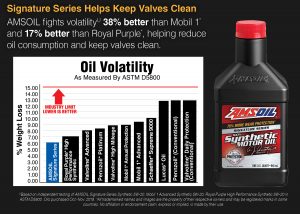Low engine oil can heighten the risk of engine wear and cause what little oil is available in the sump to breakdown sooner, creating harmful deposits. That’s one reason it’s vital to check your oil frequently.
Here are a few common reasons your engine oil might be low and what you can do about it.
Common reasons for low engine oil
Leaking gasket or seal
Your engine has several gaskets and seals that provide an oil-tight seal between metal parts. If it weren’t for the valve-cover gasket, crankshaft seals, oil-pan gasket and other gaskets and seals, oil would continually leak out between parts – and dirt and other contaminants would end up inside the engine.
Using a high-quality oil helps condition seals and gaskets so they don’t dry out, shrink or become brittle. However, if you use a low-quality oil or you don’t drive often enough to allow oil to continually circulate through the engine to condition seals and gaskets, they can begin to leak, causing low engine oil.
Pop the hood and look for oil around the valve cover or cylinder head. Check the ground under the engine for oil drops. Slide under the engine and check for oil on the oil pan.
What appears to be a couple small leaks can quickly add up over time until you’re suddenly a quart or two low on oil.
Check that the oil filter is tight; a loose filter prevents a good seal against the engine block, creating an oil leak.
If you detect leaking gaskets or seals, have them fixed and start using a good synthetic oil, like AMSOIL synthetic motor oil, that helps condition seals so they stay pliable, resist leaks and function as designed for the long haul.
A bad cylinder-head gasket is a whole different animal. If it’s bad, coolant and oil will mix, which contaminates the oil and signals a death knell for your engine. Brownish or foamy coolant is one sign of a bad head gasket. Low compression is another.
In this case, you need to have the problem fixed or it’s a matter of time before your engine blows.
Volatile motor oil
Some people don’t realize it, but motor oil can evaporate just like water, especially low-quality conventional oils.
Conventional oils contain light, unstable molecules that can evaporate in the presence of heat. The oil literally vaporizes and exits the tailpipe as exhaust emissions.
Not only that, but highly volatile oils that burn easily also can leave harmful deposits behind in the engine, which reduce performance and shorten engine life. It also leads to viscosity increase as the lighter molecules burn off, leading to a thicker oil until it can no longer pass between metal surfaces. This results in sludge formation, inability to dissipate heat, reduced wear protection and carbon deposits that reduce performance.
Using an oil viscosity that’s too low for your engine can have the same effect. For example, if your engine calls for 5W-30, a 0W-20 can be too thin for the clearances in your engine, leading to excessive oil consumption. Stick to the grade recommended in the owner’s manual.
What Does Viscosity Mean (and How Does it Affect Your Engine)?
If you burn enough oil, eventually the oil level will be low the next time you check oil.
To reduce oil consumption, use a good synthetic motor oil, like AMSOIL synthetic motor oil. Synthetics are naturally more resistant to volatility, reducing oil consumption to help your engine stay cleaner and last as designed. Reducing oil consumption also reduces the need to frequently top-off the engine.
Worn piston rings or valve seals
The piston rings and valve seals are designed to seal the combustion chamber so the engine can build enough compression to run properly.
Over time, especially if using a low-quality oil, the rings and valve seals can wear out, which allows oil into the combustion chamber to burn. Eventually, the engine burns so much oil that the oil level reads low. This is often what’s happening if you find yourself stuck behind a car that’s belching blue exhaust from its tailpipe.
This is most common in an old vehicle that’s on its last legs, meaning it may be time to think about getting another vehicle, unless you’re up for an engine overhaul.
Insufficient oil added
This sounds like a no-brainer, but it occasionally happens. For example, after changing oil the dipstick may show the correct oil level. But, after driving the vehicle and allowing the oil to circulate and fill the oil filter and oil galleys, the sump level can drop.
To avoid this, always run the engine for a couple minutes after changing oil, shut it down and let it sit for five minutes to allow the oil to drain into the sump and check the oil level again.









Comments
Share: